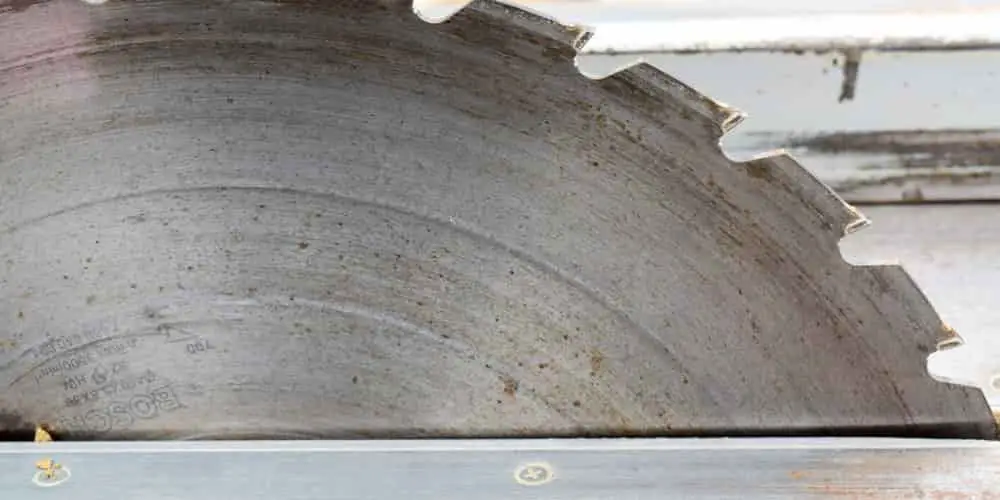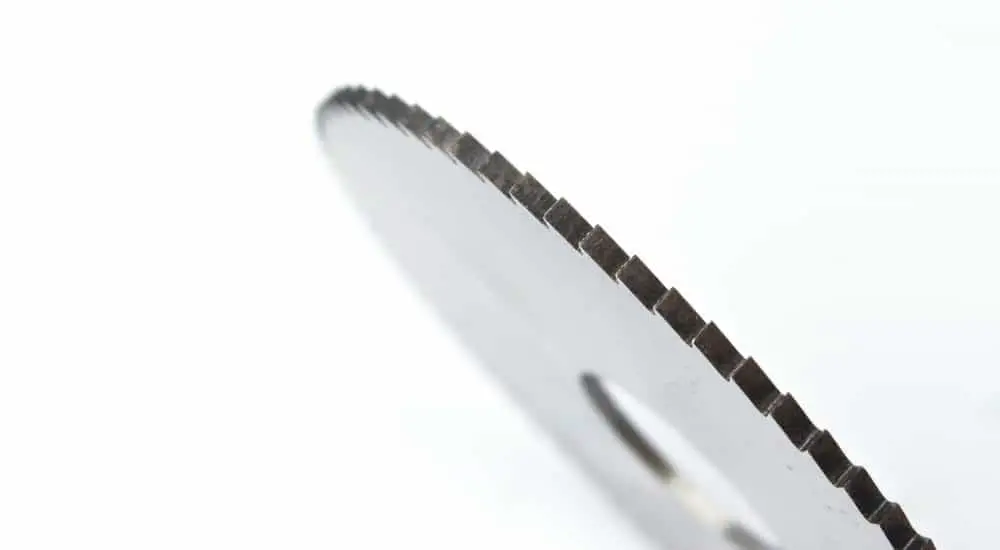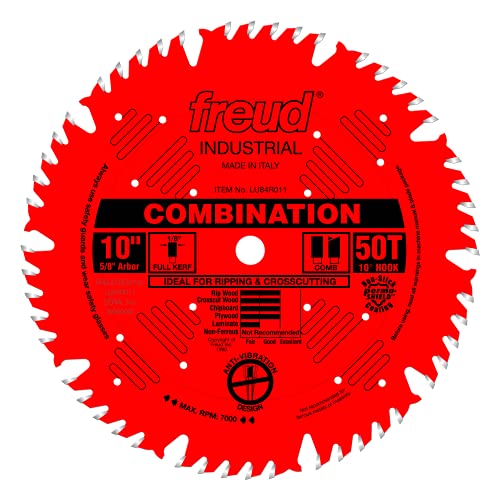If you have been using different saws for a long time, you know the ins and outs of different blades. It is clearer for you what blade size makes what and how each size impacts the task at hand. However, if you are an amateur or are yet to know how to compare the blades, you may start by looking for the best 10-inch table saw blade in the market.
To make the work easier for you, we have assembled this review to help you with the comparisons of different blades. Go through it and check out our editor’s choice, budget pick, and best quality pick. You will also read our buying guide and frequently asked questions.
Our Top Pick for the 10 Inch Table Saw Blade
Our editor’s choice for the best 10-inch table saw blade is the Freud P410: 10" Next Generation Premier.... The blade is designed for both crosscuts and rips and can work through various materials including wood, melamine, veneered plywood, laminate, and hardwood. Fitted with a high-density carbide, the blade delivers the ultimate force to enhance performance and guarantee efficiency.
10 Inch Table Saw Blade Reviews
1. Editors Choice: Freud 10" x 40T Next Generation Premier Fusion General Purpose Blade
Specifications
Key Features
Features & Benefits
- The Fusion trio features a 30o Hi-ATB which makes it perfect for grinding and slicing through melamine and plywood.
- The Freud Tools’ product is also designed with a double side grind design which allows it to deliver polished cross cuts.
- Also, the blade has an Axial Shear Face Grind designed to zip through wood and sheet goods with minimal resistance.
- The TiCo Hi-Density carbide fitted to the blade provides a sharper edge plus a flawless finish and a dramatically longer cutting life.
- The blade is also designed with Laser-Cut Anti-Vibration slots that help to reduce vibrations and sideways movement drastically. This also helps to extend the blade’s cutting life and also ensures for a crisp and splinter-free flawless finish.
- The blade is also designed with a Perma-Shield Non-Stick coating. This prevents the blade from dragging while also protecting it from corrosion as well as pitch build-up.
- The blade guarantees adaptability as it can be used to crosscut and rip laminate, wood, hardwoods, veneered plywood, and melamine.
Pros
- Versatility
- Fitted with an anti-vibration mechanism.
- It is fit for both ripping and crosscutting.
- Perma-Shield coating
- Flawless top and bottom finish.
- Smooth side finishes in crosscuts and rips.
Cons
- May leave scorch or burn marks on some wood types.
2. Budget Pick: OVERPEAK 10 Inch Table Saw Blade
Specifications
Key Features
Features & Benefits
- This Overpeak blade features a Non-Stick Perma-Shield coating which makes it more durable.
- The blade is also made of a tougher tungsten carbide material which makes it last longer.
- The blade also features 4 Laser-cut stabilizer vents and 6 Laser-cut expansion slots that help to trap noise and vibrations which ensures low noise as well as a reduction in blade warping.
- The blade is an ATB one which guarantees the user straight and smoother cross grain and rips cuts.
- It is also a versatile blade in that it can be used on a miter, table, and circular saw with an allowance of speeds of up to 6,000 rotations per minute (RPM).
- The blade is also designed for general use. The 90-tooth carbide blade is suitable for crosscut wood, ripping wood, laminate, and plywood.
Pros
- Guarantees durability.
- No splintering on softwood.
- ATB blade for cross grain cuts.
- Can be used for more than one saw like a miter saw, circular saw, and table saw.
Cons
- Ideal for softwood.
- Blade dulls quickly and can burn the wood quickly during cutting.
3. Upgrade pick: DEWALT DW7150PT 10-Inch 50 Tooth ATB Combination Saw Blade
Specifications
Key Features
Features & Benefits
- The DeWalt saw blade is able to power through non-ferrous metal and plastic materials with ease all thanks to its premium Micro-Grain and extra-sharp carbide cutting edges.
- Also, the blade has exclusive dampening slots that help to reduce vibration and increase accuracy.
- The blade is also able to offer exceptionally accurate cuts thanks to its precision-balanced and laser-cut body.
- The DeWalt saw blade is also designed with a tough coat finish which helps to reduce friction, heat, and gum which in return helps to extend the blade life.
- The blade features an anti-stick coating which helps to reduce drag and ensures the blade is protected from heat build-up, gumming and corrosion.
Pros
- Tough coat finish.
- Easy to use.
- It’s a combination blade which makes it ideal for general use.
- Considerably quiet
- Durable
Cons
- A huge amount of runout.
4. IRWIN Tools MARATHON Carbide Table / Miter Circular Blade
Specifications
Key Features
Features & Benefits
- The IRWIN saw blade is designed with #400 grit diamond-ground teeth that ensure it provides a smooth finish.
- IRWIN has also made sure the blade is precision-tensioned and balanced, features that guarantee an accurate cut.
- It also features construction-grade carbide teeth that make it last longer.
- The thin kerf ensures the blade can provide fast cuts too.
Pros
- Durability
- Smooth, clean, and fast cuts.
- It does not overheat or burn through materials.
Cons
- Spits excessive metal slivers that may stick to your skin and bleed or affect your eyes if they come into contact.
5. Freud 10" x 50T Combination Blade (LU84R011)
Specifications
Key Features
Features & Benefits
- The Freud blade combines one flat tooth for rips, four alternate top bevel teeth for crosscuts, and a large gullet to ensure an effective chip clearance.
- The large gullets in front of the flat top rakers also allow for fast ripping and easy chip removal.
- The blade is also designed with laser cut anti-vibration slots that practically eliminate the vibration that resonates in standard blades.
- The slots also reduce sideways movements in the cut which helps to extend the blade life while also offering a crisp and splinter-free flawless finish.
- It also features a Premium TiCo Hi-Density Carbide combination blend which guarantees maximum performance. The combination also reduces sideways movement.
- The blade is also designed with a Perma-Shield Non-Stick coating that helps to reduce blade rag and in return protects the blade from corrosion and any pitch build-up.
- It also features an innovative Tri-Metal blazing process that bonds the carbide tips to the steel blade body. This allows for extra flexibility and impact resistance.
- The blade also boasts of a kickback reducing shoulder design which guarantees added safety while also reducing the impacts of dangerous kickbacks.
Pros
- Does not require stabilizers.
- It is used on a variety of materials including rip, crosscut wood, chipboard, laminate, and plywood.
- Can be fitted on different saws such as a table saw portable table saw, miter saw, and radial arm saw.
Cons
- Not recommended for use on non-ferrous materials.
Buying Guide
Different saw types are designed to use specific blades. The size of the blades determines the types and size of materials the saws can be used on. As for the 10-inch table saw blade, the specifications exist too, and one might want to compare several of them and from different makers to decide which one to go for.
What is A Saw Blade?
A saw blade is the portion of a table saw that is used for slicing, scraping, or cutting through surfaces or materials. The blade is usually made from a material that is harder than what it is used on. Saw blades have been made from flaking stones in the past and nowadays from various metals like steel, ceramic, iron, bronze, and copper

Types of Table Saw Blades
The major types of saw blades include:
- Band Saw Blade: - this blade is a long band welded into a circle and has teeth on one side. It is thinner which means less waste production and dissipates heat in a better way since it is longer.
- Crosscut: - a crosscut blade is mostly used on woodworking to make cuts at or close to a right angle. It has a high tooth count and an alternate top bevel (ATB) tooth pattern. It is usually used for high-quality cuts on soft and hardwoods or chip-free cuts on human-made materials like plywood.
- Rip cut: - this blade type is also used in woodworking to make cuts parallel to the direction of the grain of the workpiece and hogs through solid woods with ease. They typically have 20-40 teeth and a flat top grind.
- Combination Blade: - a combination blade does both crosscutting and ripping. It is usually an alternate top bevel blade and is fit for most saws too.
- Strobe blade: - this is a circular blade designed with special cutters/rakers for it to saw through uncured or green wood easily since the other saw blade types may jam.
- Dado blade: - this blade is used for making wide-grooved cuts in wood so that another wood piece may fit into the groove to make joints.
- Plytooth blade: - this is a circular saw blade and has many small teeth. It is designed for cutting through plywood with minimal splintering.
How to Adjust A Saw Blade
All table saws will allow you to adjust the blades in different ways. One of the ways is by using the handwheel to control the height of the blade if you need to control the depth of cut. If it is a 10-inch blade, you can adjust it to a maximum height of 3–5/8” which will be enough to cut from 2 x 2, 2 x 4 to 4 x 4 in a single pass.
Also, you can tilt the blade with the hand wheel. The wheel is located to the side but depending on what way the arbor is made to tilt. This will help you to angle the blade for bevel or straight cuts.
What to Look for In A Saw Blade
At the heart of a woodworker’s workshop is a saw, be it a miter saw or circular saw. At the heart of the table saw is a saw blade that has to get things done efficiently for it to be anyone’s choice. With many and different types of blades in the market and each designed to serve a different purpose, it is important that one does due diligence while shopping for a blade.
The following are some of the crucial things to consider while shopping for a saw blade.
Blade Size
Every blade size is designed for making different cut styles. You should, therefore, make your selection based on your particular needs. The selection should, however, be in line with the blade manufacturer’s recommendations.
Blade Quality
The quality of the blade is not debatable and should be up to the task, regardless of the material. If you need the get the best blade, you should look for one that does not hold back on carbide or steel. The blade teeth should also be sturdy and durable.
While shopping, be sure to check out the blade diameter, central arbor hole, as well as the specifications on the user manual.
Number of Teeth
The teeth on your blade make all the difference when precision is to go by. The type of blade and what it's made for determine the number of teeth with most ranging between 24 to 80 teeth. The basic consideration here is what material you want to work on since each blade is made for different tasks.
In most cases, the fewer the teeth, the faster the cut. This is because such a blade has a larger gullet which allows for faster removal of wood chips.
On the other side, more teeth translate into smoother and sharper cuts. It also means easily cutting through materials when the teeth are many.
Materials it is Made From
Most of the existing saw blades are made from aluminum. Even though this was once a precious and expensive metal, it may not guarantee a long service life. If you are looking for a blend of precision and durability, you should go for a blade made from harder materials like carbide, steel, or titanium.
Materials to Be Cut
Each blade is designed to cut specific materials which means they may be damaged if they are used on the wrong materials. The materials and blade have to be matched too to avoid damaging them with regular blades. If you are working on plywood or melamine, for example, you should ensure the blade is specialized to cut through them.
Compatibility
When it comes to a blade, it must be compatible with the saw you are buying it for. You should make this consideration your top quality especially if you are buying the blade from a different manufacturer from the saw maker. If the blades you have at hand are larger than your saw, you should never use it since not fitting properly may cause accidents.
Teeth Coating
The coating used on the teeth may determine how long they will last. If the teeth have carbide, the coating may sustain their edges for longer while also ensuring smooth cuts and neater results. If you desire the best results here, you should at least go for a C3 grade carbide-coated blade as your minimum requirement. Such a coating allows you to sharpen it several times without depreciating the quality of the blade.
OUR TOP PICKS
The Type of Cut
The type of blade design that you choose should be determined by the type of cuts that you require it for. Rip cutting, for instance, is done with the woodgrain and will, therefore, require fewer teeth. If you are also looking for more aggression, sharper cut through, and quick and efficient chips removal, a blade with a sizeable gullet should be on your shopping list.
Kerf Width
Kerfs come either in thin or thick varieties. For each kerf size, there is the designed saw, and the user manual for each should guide you on what to go for.
Hook Angle
The hook angle plays an important role in the blade’s operation. The higher the angle, the more aggressive the cut and faster the feed rates will be. The vice versa is true and should, therefore, be among your topmost considerations depending on your applications.
Pricing
Just like with other products, you usually get what you pay for. However, high costs do not mean better and low costs do not mean poor quality. As such, you should ensure to match your needs with the right budget to ensure you grab the right blade.
FAQs
Q. What is the difference between a general purpose and combination blade?
A. A general purpose blade can be used for most wood cutting applications including on melamine, laminated wood, and plywood. A combination blade, on the other hand, is used for crosscuts and rips.
Q. Can the saw blade I buy fit any saw that I have?
A. Most of the blades are made to fit various saw types including miter, circular, and table saws. However, make sure that you follow the manufacturer's recommendations to avoid accidents.
What is the best 10 Inch Table Saw Blade: Our Picks
We feel that the Freud P410: 10" Next Generation Premier... makes it to our editor’s choice of the best 10-inch table saw blade. With a 40-tooth design, 5/8-inch arbor and a 10-inch diameter, the blade guarantees efficient and polished cutting through melamine, laminate, veneered plywood, and hardwoods. Since it’s a general-purpose blade, you can use it for making up to 3/8" to 3-1/2" crosscuts and 3/4" to 1-1/2" rips.
Our budget pick goes to the Overpeak 10-Inch Table Saw Blade ATB... which is also an alternate top bevel (ATB) teeth blade. It boasts of a 90-tooth design, low noise and cutting stability. It is meant for general usage with crosscut woods, plywood, laminate, and rips and is a lower budget product.
The upgrade pick goes to the DEWALT DW7150PT Combination Saw Blade a 50-tooth combination saw blade. Boasting of a tough coat finish, it guarantees the user of a longer lifespan while also ensuring they get balanced precision and cutting accuracy.
References & Further Reading
- 10" Thin Kerf Next-Generation General Purpose Blade – Freud Tools
- Large Diameter Precision Saw Blades - DeWalt
- 10” Combination Blade (LU81R011) – Freud Tools
- Woodworking 101: The 3 Table Saw Blades Woodworkers Should Have – Woodworkers Source
- Types of blades and blade cuts – Wikipedia
- 3 Great Table Saw Blades – Woodworkers Guild of America
- Choosing the Right Table Saw Blades - Woodworkers Guild of America (Video)
- Table Saw Blade Selection – Woodworkers Guild of America (Video)
- How Do I Choose the Right Saw Blade
Last update on 2024-04-05 / Affiliate links / Images from Amazon Product Advertising API









